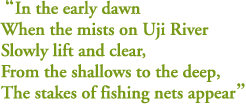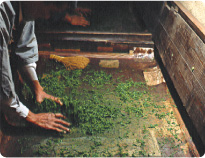
Ujicha is cultivated on the bedrock of a long history and time-honored traditions. Even today, tea touches the lives of Kyotoites on a daily basis and is ingrained in our collective cultural consciousness. This section was designed to share a little bit of that culture and history with you.
Tea originated in India from whence it slowly made its way to the rest of the world, becoming widely consumed in China as long as four thousand years ago. Tea history in Japan is said to originate with Zen master Eisai who brought tea seeds back to Kyoto from a trip to China in the late 12th century. Eisai wrote a book entitled "How to Stay Healthy by Drinking Tea," wherein he explained the various medicinal effects of tea and encouraged its consumption. Thus Eisai is credited with forming the base for tea culture in Japan.
 The cultivation of good tea is largely dependent on climatic conditions, and with its proximity to the river and moderate temperatures, Uji is ideal. The first tea cultivated in Uji is said to have been at the hands of the High Priest Myoe of Kozanji Temple at Toganoo. Zen master Eisai shared some of the seeds he brought back from China with Myoe who planted them in a place called Toganoo Fukase. When the seedlings were ready to be transplanted, Myoe chose Uji as the model region to grow tea trees and manufacture tea on a larger scale. This was the origin of the History of Ujicha, and the first of many steps taken by High Priest Myoe in his efforts to spread the joy of drinking green tea throughout Japan.
The cultivation of good tea is largely dependent on climatic conditions, and with its proximity to the river and moderate temperatures, Uji is ideal. The first tea cultivated in Uji is said to have been at the hands of the High Priest Myoe of Kozanji Temple at Toganoo. Zen master Eisai shared some of the seeds he brought back from China with Myoe who planted them in a place called Toganoo Fukase. When the seedlings were ready to be transplanted, Myoe chose Uji as the model region to grow tea trees and manufacture tea on a larger scale. This was the origin of the History of Ujicha, and the first of many steps taken by High Priest Myoe in his efforts to spread the joy of drinking green tea throughout Japan.
 At the gates of Manpukuji Temple in Uji, there is a stone monument with an engraved poem by High Priest Myoe: " From the Hillside of Toganoo, A Horse was led and where it left hoof prints, Seedlings were planted, One at each." The legacy of this poem can be seen today in the bountiful tea fields of Uji.
At the gates of Manpukuji Temple in Uji, there is a stone monument with an engraved poem by High Priest Myoe: " From the Hillside of Toganoo, A Horse was led and where it left hoof prints, Seedlings were planted, One at each." The legacy of this poem can be seen today in the bountiful tea fields of Uji.

 This is one of one-hundred famous ancient poems of Japan compiled in the anthology Ogura Hyakunin-Isshu. The climate in the Uji River region is ideal for the cultivation of tea as the river mist keeps the tea moist and cool but never frosty. This is why High Priest Myoe chose this place to plant his seedlings, marking the beginning of a long history of Ujicha.
This is one of one-hundred famous ancient poems of Japan compiled in the anthology Ogura Hyakunin-Isshu. The climate in the Uji River region is ideal for the cultivation of tea as the river mist keeps the tea moist and cool but never frosty. This is why High Priest Myoe chose this place to plant his seedlings, marking the beginning of a long history of Ujicha.
 In 1738, there was a great technological breakthrough in the manufacturing of Ujicha. Pan roasting, which had been the standard until that point, was replaced by a hand-rolling method discovered by Souen Nagatani, one of the prominent tea manufacturers in Uji at that time. This breakthrough provided impetus for further innovations that followed one after another, and Uji quickly earned nationwide repute as the most important region of green tea manufacture in Japan.
In 1738, there was a great technological breakthrough in the manufacturing of Ujicha. Pan roasting, which had been the standard until that point, was replaced by a hand-rolling method discovered by Souen Nagatani, one of the prominent tea manufacturers in Uji at that time. This breakthrough provided impetus for further innovations that followed one after another, and Uji quickly earned nationwide repute as the most important region of green tea manufacture in Japan.





